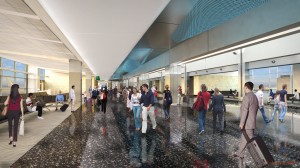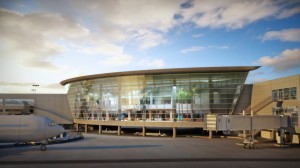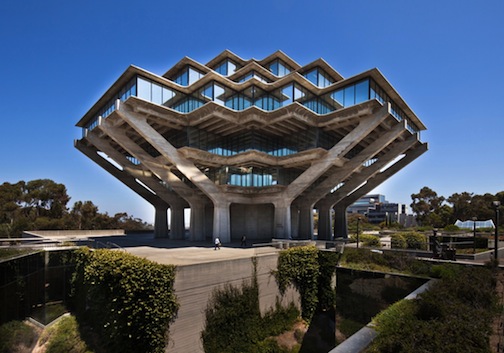Cover Story
Reinventing Lindbergh Field
Airport Authority puts a new spin on Lindbergh’s decades-old problems
By Manny Cruz
Five years have elapsed since county voters rejected an advisory ballot measure for the relocation of Lindbergh Field, a long-festering issue that has been fiercely debated for the past four decades. A year after that vote, Alan Bersin, then the chairman of the San Diego County Regional Airport Authority — the agency overseeing the airport — sought to put the issue to rest once and for all. “Our job,” he said, “is to end the San Diego airport controversy, this 40-year endless debate. “We’re building a new airport — at Lindbergh Field.”
In fact, the Airport Authority is reinventing Lindbergh Field, casting off the controversies of the past and moving ahead to expand and streamline airport operations, attract new air carriers, create new concession opportunities for local companies and ease the airport experience for the thousands of passengers who utilize the airport each year — currently at 17 million.

The push to improve airport operations stems from studies indicating that Lindbergh Field (San Diego International Airport) — the busiest single runway airport in the nation — will reach its maximum capacity some time after 2015 which, if not addressed quickly, could result in automobile traffic congestion surrounding the airport, long lines for tickets and security checks, higher ticket prices, difficulties in obtaining flights in and out of San Diego and airline defections. Studies also have shown that San Diego’s tourism industry would suffer and businesses that rely on air transportation services would relocate elsewhere.
The ambitious airport expansion and improvement program is being handled under the tutelage of Thella Bowens, president and CEO of the Airport Authority. She was appointed to the post in 2003 after state legislation removed the airport from the control of the San Diego Unified Port District and placed it in the hands of the newly created Airport Authority. Bowens had been the Port’s senior director of aviation for seven years before the switch, and when the changeover occurred she was given the responsibility of planning and implementing the transfer of the airport to its role as an independent entity.
Bowens, who works under a contract that gives her an annual salary of $258,323, says running the airport is no different than running a business. “We are a business,” she says, emphasizing the word. “We are a business that operates in the public arena and we are subject to all of the public laws that govern public organizations… Our stakeholder is the general public. Our emphasis is on being a really good, publicly operated entity.”
Green Build In Progress

The most visible part of the airport’s “reinvention” is the $1.2 billion Green Build at Terminal 2, the largest improvement project in airport history. When completed in 2013, the terminal will have 10 new gates, a dual-level roadway where arriving and departing passengers can conduct their business on separate curbs, more overnight parking spaces and more dining and shopping options, among other improvements.
“It includes the waiting room for those new gates, it includes the new concession core where you will see just a lot of the new concessions that are coming in through the process than we had just a few months ago,” says Bowens. “It includes over a million square feet of additional aircraft parking apron which is really going to help our efficiency because we will no longer have to park our overnight aircraft over on the north side and then in the morning have them come through the traffic to get over here…
“All real airports have dual level roadways, and that’s very important to us because if you have used Terminal 2, you know that the curb front here is very, very congested and that is because we have totally outgrown in terms of numbers, the number of passengers and the number of cars that we have the ability to handle on one level. If we can separate the departures and arrivals on separate levels, you really cut down the congestion. When you cut down on the congestion, you cut down on emissions and other issues that go on as a result of that. So we’re looking to not only ease the passenger’s experience, but to contribute to a better level of quality by having that traffic continue to move.”
Food and Retail Concessions

The airport’s new food and retail concession program will be implemented throughout the facility — Terminals 1 and 2 and the Commuter Terminal. It is a major departure from the past, where one company ran all airport concessions. San Diegans will see some familiar local dining choices in the new system, such as Jack in the Box (but not McDonalds), and a lot of other eating spots operated by local businesses that will be operating at the airport for the first time, such as Pannikin Coffee & Tea, Saffron Thai, Phil’s BBQ, and Stone Brewing Company, to name a few. On the retail side, a new feature at the airport will be Spa Didacus’ Be Relax Spa in two locations. In all, the Airport Authority board approved 16 food and retail packages. Travelers will begin seeing the new shops, restaurants and services beginning in December 2012.
“One of the things that we wanted to do was to provide what in this industry is called a local flavor,” says Bowens. “It means that you want your airport to reflect your local community, your local culture, things that are indigenous to your culture, things that people in this market, who come to this market would expect to see and for people who live in this market are comfortable with. (Although) you cannot under federal guidelines give any preference to a local company, you can create a program that reflects the local culture and when you do that, you really open the avenue for more local companies to be participants.”
Bowens says the “local flavor” feature is new to San Diego, but not elsewhere. “That’s something that’s happening in airports across the country,” she says. “If you go to St. Louis for instance, you are going to see things that really reflect St. Louis. If you go to DFW ( Dallas/Fort Worth) you’re going to see Bar-B-Q, and the Texas wine country and so that’s what we’re trying in San Diego. If you noticed the concessions in the past, they have been mostly national brands and that was the trend 15-20 years ago. And now the trend is really to create a sense of place. To a person just walking off the plane, he might say, ‘wow, I know I’m in San Diego because I see something that’s very San Diego related.’”
Financing
According to the Port Authority, the Green Build project will top out at $1.2 billion, which includes $865 million in direct construction costs and financing costs of about $145 million. Money from airport user fees, concessions, revenue bonds and grants from the Federal Aviation Administration are being used to finance the project.
Aside from the physical improvements at the airport, the Airport Authority works aggressively to bring more air carriers into Lindbergh Field. It currently has 18 passenger carriers, the largest being Southwest Airlines, (which carried 37 percent of the airport passenger volume in 2010), and four cargo carriers. “We work in collaboration with ConVis, the chamber, the Economic Development Corporation, the World Trade Center,” says Bowens. “We work very, very closely with the business community to develop those relationships with the airlines, to develop those relationships with the business traveler so that we can go to a particular airline and make a presentation that helps them to see the value of San Diego to their business. The actual decision by the airlines to come here is really a testament to this community because this community, despite how bad the economy is to us, it has not taken the same hit as a lot of other communities, so we’re seeing airlines come in here because the travelers are here.
“They know they can come in here, put their equipment here, and make a profit and that’s the only way they will continue to do that. And I always say if we get nonstop service to a market, it’s very important that people use it because it is a ‘use it or lose it’ proposition. If they can’t make money, they will pull out. They have no community loyalty. The loyalty is to the stockholder and to the bottom line.”
Terminal 1
A plan for the replacement of Terminal 1 will be a focus of the upcoming Airport Development Plan, which is the next phase of airport master planning. The planning process is slated to begin in early 2012, allowing two years for planning and two years for environmental documentation. Upon adoption of the state and federal environmental documents, work can begin.
No cost estimates are yet available. “It is way too early to have a sense of cost for something that has not been planned and designed,” said Steven Shultz, deputy director of public relations for the Airport Authority.
The Capacity Issue
Although Lindbergh Field is constrained by its location, its single runway and no viable relocation options (she calls it a dead issue), Bowens doesn’t dwell much on the issue of the airport running out of capacity. “I’m sure I’ll be retired (by then),” she says. “And I will sit back and watch the next group go through what we went through in 2003-2006 to look at all the solutions. And with technology and changes in technology and changes in the demographics of the traveler, the advent of things like high-speed rail, it will change some of the decisions-making assumptions that you use when you do those kinds of studies. Right now, our job is really to make this work. Because the voters spoke about what they wanted: they didn’t want us to move the airport at that point. And so, I don’t know what’s down the road.”
Economic Asset
“One of the things that I always like to talk about and I don’t think people really realize it is that the airport is a tremendous economic asset to the community,” Bowens says. “It is a major engine in terms of helping businesses to develop and having people come here. We’re a great tourist and convention market. But we also have great businesses here that depend on air travel and having the right air service and the right facilities to support that air service is just really, really critical in a city like San Diego. People who don’t regularly study this business don’t realize that the companies like Qualcomm and the universities and all the biotech and all those industries depend very heavily on not just air service, but great air service to the extent that we make it efficient. We save them time and therefore, we save them money. This airport is a critical asset; we don’t really dip into the tax funds of this community. We generate a lot of revenue for this community and the green build itself is generating at its peak about 1,000 jobs and the new concession program will generate lots of new jobs, lots of new opportunities. So everything that we do here is really a great support economically to the community.”
San Diego International Airport Quick Facts
Acres: 661; established: 1928
Total employees: 6,377
Passengers per day: 40,000-50,000; 53 percent leisure, 43 percent business
Daily arrivals and departures: 550
Nonstop destinations: 48
Passenger totals: 16.9 million in 2010
Gates: 41 gates for jet aircraft in Terminals 1 and 2; 4 gates for regional planes in Commuter Terminal
Airlines: 18 passenger carriers and 4 cargo carriers
Largest carrier: Southwest; 37 percent of passenger volume in 2010
2010 operations-air carrier: 79 percent; general aviation: 17.5 percent; cargo 3 percent; military: .5 percent
Economic impact: SDIA contributes some $10 billion annually to the region
Job creation: Approximately 115,000 jobs, or one of every 16 jobs in the region, are directly or indirectly related to operations at the airport
Airport Authority: 340 Authority employees; $151 million operating budget for FY2012
Green Build
New gates: 10 at Terminal 2 West
Dual-level roadway at Terminal 2: arrivals and departures on separate curbs
Smart curb technology: travelers can check in for their flight even before entering the terminal
Aircraft parking: additional remain-over-night parking
New, expanded dining and shopping options
More and improved security checkpoints
Funded by user fees, airport revenue bonds, airport cash and FAA grants, not by local tax dollars
Cost: $1.2 billion—$865 million for the project; remainder in financing costs
Sustainability: Pursuing Leadership in Energy and Environmental Design (LEED) silver certification. Sustainable design elements include: Decreased water usage; reduced energy consumption; use of alternative energy sources

